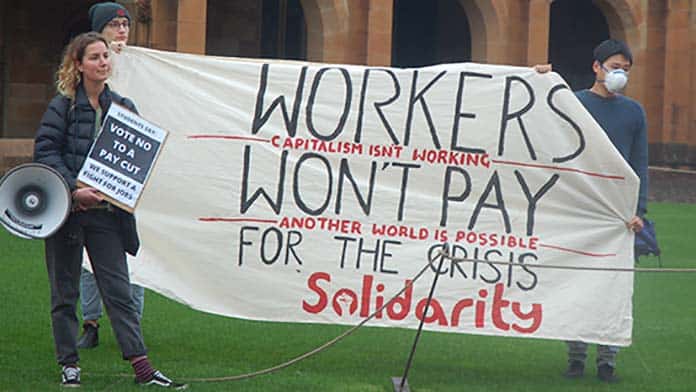The pandemic has thrown hundreds of thousands out of work. Unofficial employment is already at 9 per cent, and is expected to keep rising until the end of the year.
Yet Scott Morrison is already cutting back JobKeeper and JobSeeker payments. Both have been cut back from the end of September by $300 a fortnight.
Together, this will push 740,000 more people into poverty this month, the ANU Centre for Social Research and Methods calculates.
Many will be cut off JobKeeper altogether, and now risk losing their job. Around 2.1 million workers are expected to lose the payment. Ben Johnston from accounting firm Johnston Advisory told News Corp that this means, “only about a third of current JobKeeper recipients will be eligible come October”, due to changed eligibility rules. In total there will be a $1.5 billion cut to JobKeeper income support per fortnight.
There are promises of further incentives for businesses and more funding for infrastructure in the budget on 6 October.
But these are unlikely to be anything on the scale needed to create jobs. Morrison has announced hundreds of millions in government funding to expand gas production, but is not funding the investment in renewable energy and climate action that is needed.
There is no talk of providing the funding to properly staff aged care centres, despite the disaster inadequate staffing produced during Melbourne’s COVID-19 outbreak.
Sackings are already beginning to mount. In recent weeks Qantas has sacked 2500 ground crew on top of 6000 other staff, 550 jobs have gone at Suncorp bank, and 600 at JBS’s abattoir in Dinmore, Queensland.
At universities, there have already been 11,000 job losses announced, and the University bosses’ association expects job cuts to reach 21,000 by the end of the year.
This is, in part, the result of Scott Morrison’s vindictive decision to deny university workers access to JobKeeper payments. Despite universities’ loss of income due to falling international student enrolments, there has been no emergency funding package. Instead the Liberals have decided to punish universities further, through increasing student fees and making any increase in funding reliant on increasing class sizes.
Its plans for fee increases will come back before the Senate in the week of October 6.
Predictably, the university Vice-Chancellors have meekly accepted the legislation imposing fee increases. They are using the opportunity of the COVID-19 crisis to push through job cuts and restructures that have been long in the works. Sydney University has admitted it now expects a budget surplus this year, but is already asking for voluntary redundancies.
Fighting the cuts
Hundreds of staff have attended union meetings at Melbourne Uni and Sydney Uni to oppose job cuts. The anger at these meetings has to be turned into protest action that prepares the way for strikes.
Students at Sydney University have led the way in beginning to organise against the cuts, as the university plans to sack up to 30 per cent of its staff.
Hundreds of students have joined a series of demonstrations.
Outrageously, police have broken up the protests, even when students and staff held separate gatherings widely dispersed across the campus on 16 September, all less than 20 people in size as allowed under COVID-19 regulations.
Dozens have now received fines and one protester has been arrested and charged under the COVID-19 rules. This is a serious escalation of the NSW police’s attack on the right to protest. Police are attempting to effectively ban any kind of protest action.
Police have used the COVID-19 crisis to push for greater and greater powers. In Brisbane 18 people were arrested at a protest following the death in custody of Indigenous woman Aunty Sherry Tilberoo.
It’s clear there is a political campaign to target and ban protests. On the very same day that the Sydney Uni protest was broken up, NSW Premier Gladys Berejiklian foreshadowed plans to relax restrictions on football stadiums to allow up to 40,000 people from October. The Catholic Church was granted an exemption on the Saturday following to allow 300 people to attend a mass at St Mary’s Cathedral for an ordination. Yet outdoor protests remain limited to a maximum of 20 people.
It’s crucial we continue to find ways to organise protests and challenge the restrictions. These have to involve the widest number of people possible in standing up to the police.
In Sydney, there are plans for another day of action on 14 October, involving university staff and the NTEU on a much more serious scale than previous actions. Winning the unions to take action will bring greater social weight to the effort to defend the right to protest. And it will help build confidence and momentum to move towards the kind of strike action that will be necessary to stop Morrison and the university bosses’ cuts.






